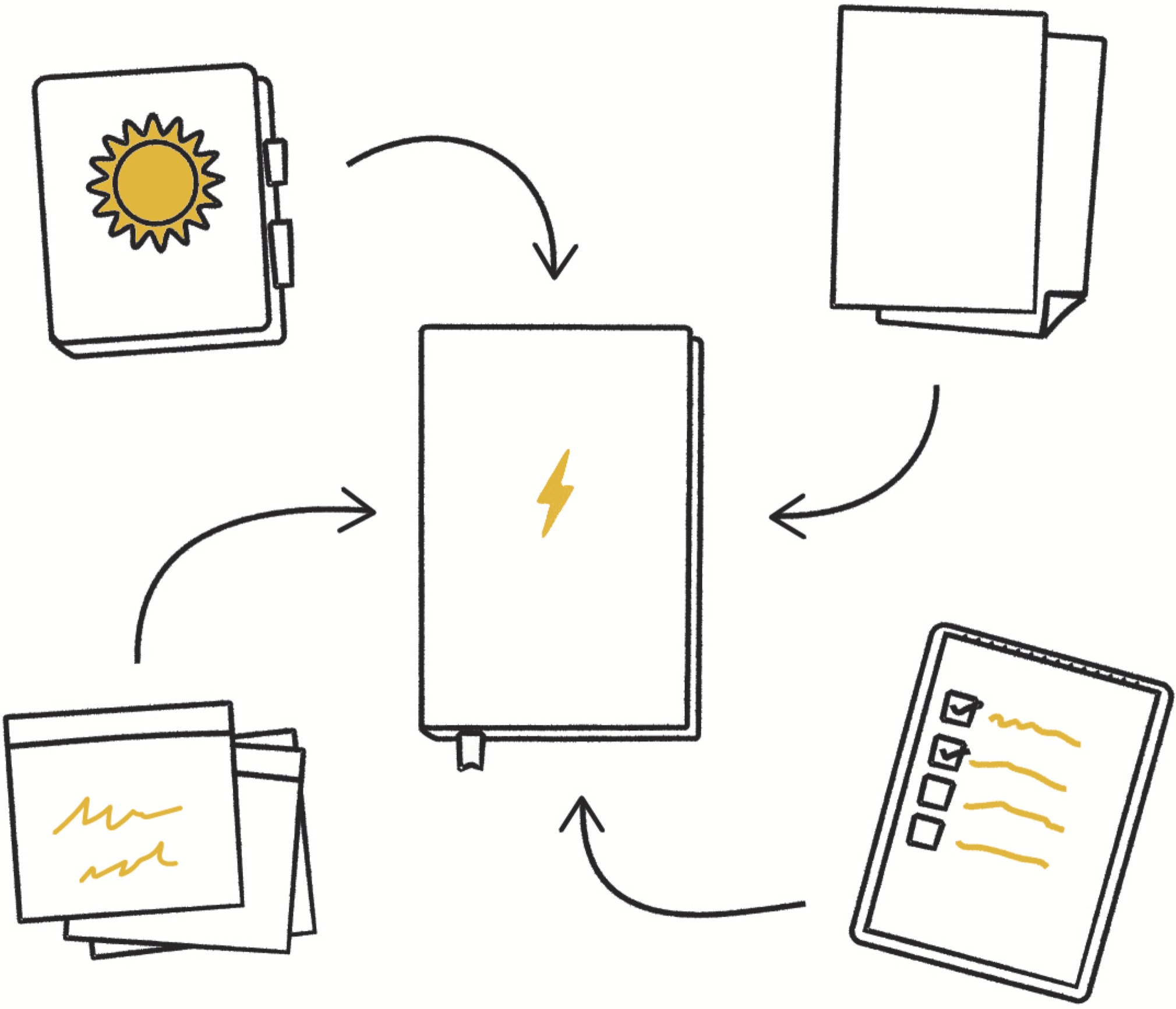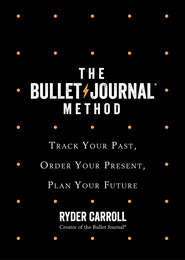
Полная версия:
The Bullet Journal Method
Have nothing in your homes that you do not know to be useful or believe to be beautiful.
—WILLIAM MORRIS
Studies have suggested that we have 50,000 to 70,000 thoughts per day.8 For context, if each thought were a word, that means our minds are generating enough content to produce a book Every. Single. Day. Unlike a book, our thoughts are not neatly composed. On a good day they’re vaguely coherent. This leaves our minds perpetually struggling to sort this gray matter gallimaufry. Where do you even begin? What comes first? Inevitably we find ourselves tackling too many things at the same time, spreading our focus so thin that nothing gets the attention it deserves. This is commonly referred to as “being busy.” Being busy, however, is not the same thing as being productive.
For most of us, “being busy” is code for being functionally overwhelmed.
What do I mean by that? We don’t have time because we’re working on a lot of things, yet things aren’t working out a lot of the time. This phenomenon isn’t just a twenty-first-century problem, but it has been exponentially exacerbated by the countless number of choices technology has put at our fingertips. Should we type, text, call, email, swipe, pin, tweet, Skype, FaceTime, Zoom, Message, or yell at our digital assistant to get it done, whatever it is? And in what order should all of that happen? (Oh, and before we can get started, we’ll have to upgrade, update, reboot, log in, authenticate, reset our password, clear cookies, empty our cache, and sacrifice our firstborn before we can get where we’re going . . . where was that again?)
This freedom of choice is a double-edged privilege. Every decision requires you to focus, and focus is an investment of your time and energy. Both are limited—and therefore exceptionally valuable—resources.
Warren Buffett, one of the most successful investors of all time, gave the following advice to his trusty pilot Mike Flint. They had been discussing Flint’s long-term plans. Buffett asked Flint to draft a list of his top 25 career goals. When he was done, Buffett asked Flint to circle his top five. When asked about the ones he circled, Flint replied, “Well, the top five are my primary focus, but the other twenty come in a close second. They are still important, so I’ll work on those intermittently as I see fit. They are not as urgent, but I still plan to give them a dedicated effort.”
To which Buffett replied, “No. You’ve got it wrong, Mike. Everything you didn’t circle just became your Avoid-At-All-Cost list. No matter what, these things get no attention from you until you’ve succeeded with your top five.”9
In an interview published in Vanity Fair, President Barack Obama said, “You’ll see I wear only gray or blue suits. I’m trying to pare down decisions. I don’t want to make decisions about what I’m eating or wearing. Because I have too many other decisions to make.”10 The same is true of Facebook founder Mark Zuckerberg with his gray hoodies, or Apple founder Steve Jobs and his famous black-turtleneck-and-jeans uniform. Acutely aware of how taxing deliberating over options can be, they sought every opportunity to limit choice in their lives.
As psychologist Roy F. Baumeister wrote in his book Willpower: “No matter how rational and high-minded you try to be, you can’t make decision after decision without paying a biological price. It’s different from ordinary physical fatigue—you’re not consciously aware of being tired—but you’re low on mental energy.”11 This state is known as decision fatigue. In other words, the more decisions you have to make, the harder it becomes to make them well. This is why you’re more likely to eat an unhealthy dinner at the end of the day than an unhealthy breakfast at the beginning of the day, when you have a full tank of willpower.
Left unchecked, decision fatigue can lead to decision avoidance. This is especially true for big life choices, which we tend to put off till the last minute. Daunting choices don’t simply vanish; they wait in the wings, steadily becoming more menacing. Where do I want to go to college? Do I want to marry this person? Should I take that new job? By the time you’re finally forced to make a decision, at the tail end of all the other decisions you’ve been making to avoid having to make this big one, chances are you don’t have a lot of focus left to spare. No wonder we often feel stressed, anxious, and overwhelmed.
We try to treat these symptoms with even more distractions. Drinking, eating, traveling, binge-watching, etc. Even though your Netflix queue is four years long, somehow nothing looks good! You can’t decide, and now you’re even more stressed. In order to make a lasting difference, we need to address not the symptoms but the cause.
We need to reduce the number of decisions we burden ourselves with so we can focus on what matters.
The Mental Inventory
The first step to recovering from decision fatigue, to get out from under the pile of choices weighing on you, is to get some distance from them. You need some perspective to both clearly identify and corral your choices. We do this by writing them down. Why write them down? Each decision, until it’s been made and acted on, is simply a thought. Holding on to thoughts is like trying to catch fish with your bare hands: They easily slip from your grasp and disappear back into the muddy depths of your mind. Writing things down allows us to capture our thoughts and examine them in the light of day. By externalizing our thoughts, we begin to declutter our minds. Entry by entry, we’re creating a mental inventory of all the choices consuming our attention. It’s the first step to taking back control over our lives. Here is where you can begin to filter out the signal from the noise. Here is where your Bullet Journal journey will begin.
Just like when organizing a closet, we need to take everything out before we can decide what stays and what goes. Creating a mental inventory is a simple technique that will help you quickly take stock of what you’ve been jamming into your mental closet. Chances are there are a lot of useless responsibilities hogging valuable mental and emotional real estate up there.
To begin, sit down with that sheet of paper I mentioned you’d be needing. Orient it horizontally and divide it into three columns (you can either fold it twice or draw the lines like in the Mental Inventory on this page).
1 In the first column, list all the things you are presently working on.
2 In the second, list all the things you should be working on.
3 In the last column, list the things you want to be working on.
Keep your entries short and in list form. If one task sparks a stream of others, go with it. Give yourself some time with this exercise, and dig deep. Be honest. Get it out of your head (and your heart) and lay it out on the page. Take a deep breath and begin.
MENTAL INVENTORY
Working on
Taxes
Presentation for Acme Co
Cleaning up photo library
Emmy dinner party planning
Should be working on
Workout plan
Learn how to invest
Weekly meal plans
Set 5-year goal
Call ’rents
Get a checkup
Retirement plan
Want to be working on
Plan trip to Hawaii
Learn to cook
Learn another language
Read more
Write more
Lose 10 pounds
More time with friends
The Test
This Mental Inventory you just created provides a clear picture of how you’re currently investing your time and energy. It’s a map of your choices. The next step is to figure out which ones are worth making.
We’re so busy with all the things we’re doing (or should be doing) that we forget to ask ourselves why we’re doing these things. We end up burdening ourselves with all sorts of unnecessary responsibilities. The Mental Inventory grants us the opportunity to take a step back and ask why.
Go ahead, ask why for each item on your list. You don’t need to dive down an existential rabbit hole. Simply ask yourself two questions:
1 Does this matter? (To you or to someone you love)
2 Is this vital? (Think rent, taxes, student loans, your job, etc.)
TIP: If you struggle to answer these questions about a given item, ask yourself what would happen if said item just didn’t get done. Ever. Would there be any real repercussions?
Any item that doesn’t pass this test is a distraction. It adds little to no value to your life. Cross it off. Be ruthless. Keep in mind that each task is an experience waiting to be born, offering a glimpse into your potential future. That’s why everything on your list has to fight for its life to stay there. More accurately, each item needs to fight for the opportunity to become part of your life.
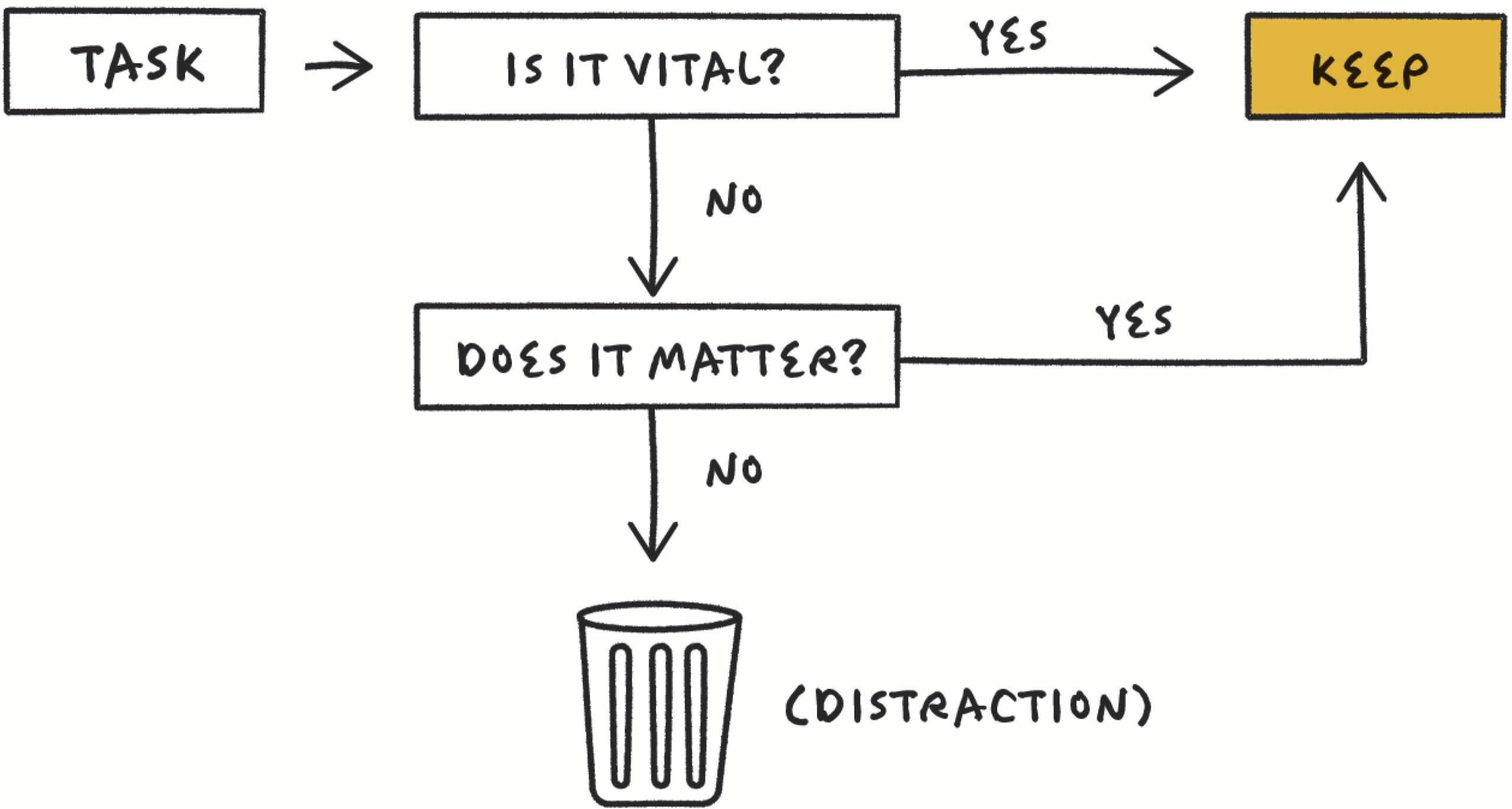
When you’re done, you’ll probably be left with two types of tasks: things you need to do (your responsibilites) and things you want to do (that is, your goals). Throughout the course of this book, I will show you ways you can push forward on both fronts. For now, though, you have all the ingredients needed to populate your Bullet Journal. All, that is, except for your notebook.
Now you may be asking, Why didn’t we just do this in our notebook? It’s a fair question. As you read this book, ponder the ideas, and try out the techniques, you might find yourself paring back your Mental Inventory even more. When you christen your Bullet Journal, you should do so with only things that you believe are important or will add value to your life. Being intentional about what you let into your life is a practice that shouldn’t be limited to the pages of your notebook.
NOTEBOOKS
Journal writing is a voyage to the interior.
—CHRISTINA BALDWIN
People who are new to BuJo often ask about the notebook. Can’t we just use an app for keeping lists? The short answer is sure. In fact, there are a lot of good productivity apps out there. I worked on some myself! As a digital product designer, I can fully appreciate how powerful and effective digital tools can be. In fact, the Bullet Journal was designed using some methodologies leveraged in software development. That said, there’s a lot more to Bullet Journaling than keeping lists. It’s a comprehensive methodology designed to help us capture, order, and examine our experience. As you move through this book, you’ll see exactly how and why your notebook will serve you well in this regard. Here, we’ll look at the foundational reasons behind the notebook.
Technology removes barriers and distances between people and information. We can learn about almost anything, or communicate with anyone, at any time, from anywhere, just by tapping our phone. It’s a convenience that we avail ourselves of, on average, every 12 minutes!12 All of this convenience, however, comes at a price—and I don’t mean the cost of your data plan, your cable bundle, or the pieces of your soul you sacrifice as you try to reason with your provider’s customer service.
In a world where Wi-Fi boosters are attached to church steeples, no place remains sacred.13 From the boardroom to the bathroom, technology has flooded our lives with more content than we can possibly absorb, washing away our attention spans in the process. Studies suggest that your concentration suffers simply by having your smartphone in the room with you, even if it’s silent or powered off!14
In 2016, the average American spent nearly eleven hours in front of digital screens each day.15 Factoring in six to eight hours of sleep (which is also compromised by our phones16), we’re left with around six hours of non-screen time per day. Now consider the time spent commuting, cooking, and running errands, and you can see where this is headed: We’re steadily decreasing the amount of time we have to stop and think.
Sitting down with your notebook grants you that precious luxury. It provides a personal space, free from distraction, where you can get to know yourself better. This is one of the main reasons we use a notebook to Bullet Journal: It forces us to go offline.
Our notebook serves as a mental sanctuary where we are free to think, reflect, process, and focus.
The blank pages of your notebook offer a safe playground for your mind, where you’re completely free to express yourself without judgment or expectation. As soon as you put pen to paper, you establish a direct link to your mind and often your heart. This experience has yet to be properly replicated in the digital space. It’s why, to this day, so many ideas are born on scraps of paper.
Another reason we use notebooks? Flexibility. Software tends to be either so powerful that its wealth of features is buried to all but the most intrepid explorers (think Excel) or so specific that it sacrifices features for increased usability, essentially doing few things very well (think mobile apps). In both cases, they force you to operate within a framework of their choosing. This is the main challenge with many productivity systems: They struggle to address the limitless variability and evolutionary nature of our individual needs. Notebooks, in contrast, are beholden to their authors. Their function is limited only by the imagination of their owner.
The power of the Bullet Journal is that it becomes whatever you need it to be, no matter what season of life you’re in.
In school, it can serve for your class notes. At work, it can be a tool to organize your projects. At home, it can help you set and track your goals. Robyn C., for example, was able to meditate for 432 consecutive days by designing a meditation tracker in her Bullet Journal. She did the same when trying to figure out what triggered her sleeping disorder. I didn’t invent her tools; she did.
Because of the way the Bullet Journal is structured, it can be multiple things at the same time. Rather than a tool, think of it as a tool kit. It allows you to funnel a lot of your productivity needs into one place. You’ll enjoy a more comprehensive perspective on your life, one that can allow you to spot unconventional connections. As Bullet Journalist Bert Webb put it: “As I do daily, weekly, and monthly reviews, leafing forward and backward in my Bullet Journal, my brain inevitably makes more links between ideas that I was not able to do when using my various separate digital tools.”
The other great thing is that you start fresh each day. With digital trackers, you step onto their track—somewhere in the middle of the endless race that started when you set up the tracker and ends . . . ? Your notebook greets you each morning with the pure, blank slate of an empty page. It serves as a small reminder that the day is as yet unwritten. It will become what you make of it. As Bullet Journalist Kevin D. notes: “I used to feel bad about items undone at the end of the day, but with the Bullet Journal I feel empowered to move yesterday’s open bullets forward to a new page, because I see each day as a fresh start.”
Finally, your notebook evolves as you do. You might say that you co-iterate. It will conform to your ever-changing needs. The lovely side effect is that as the years pass, you’re creating a record of your choices, and the ensuing experiences. As Bullet Journalist Kim Alvarez once put it, “Each Bullet Journal contributes another volume to a library of your life.” In the pursuit of meaning, this library becomes a powerful resource to have at your disposal.
By recording our lives, we’re simultaneously creating a rich archive of our choices and our actions for future reference. We can study our mistakes and learn from them. It’s equally instructive to note our successes, our breakthroughs. When something works professionally or personally, it helps to know what our circumstances were at the time and what choices we made. Studying our failures and our victories can provide tremendous insight, guidance, and motivation as we plot our way forward.
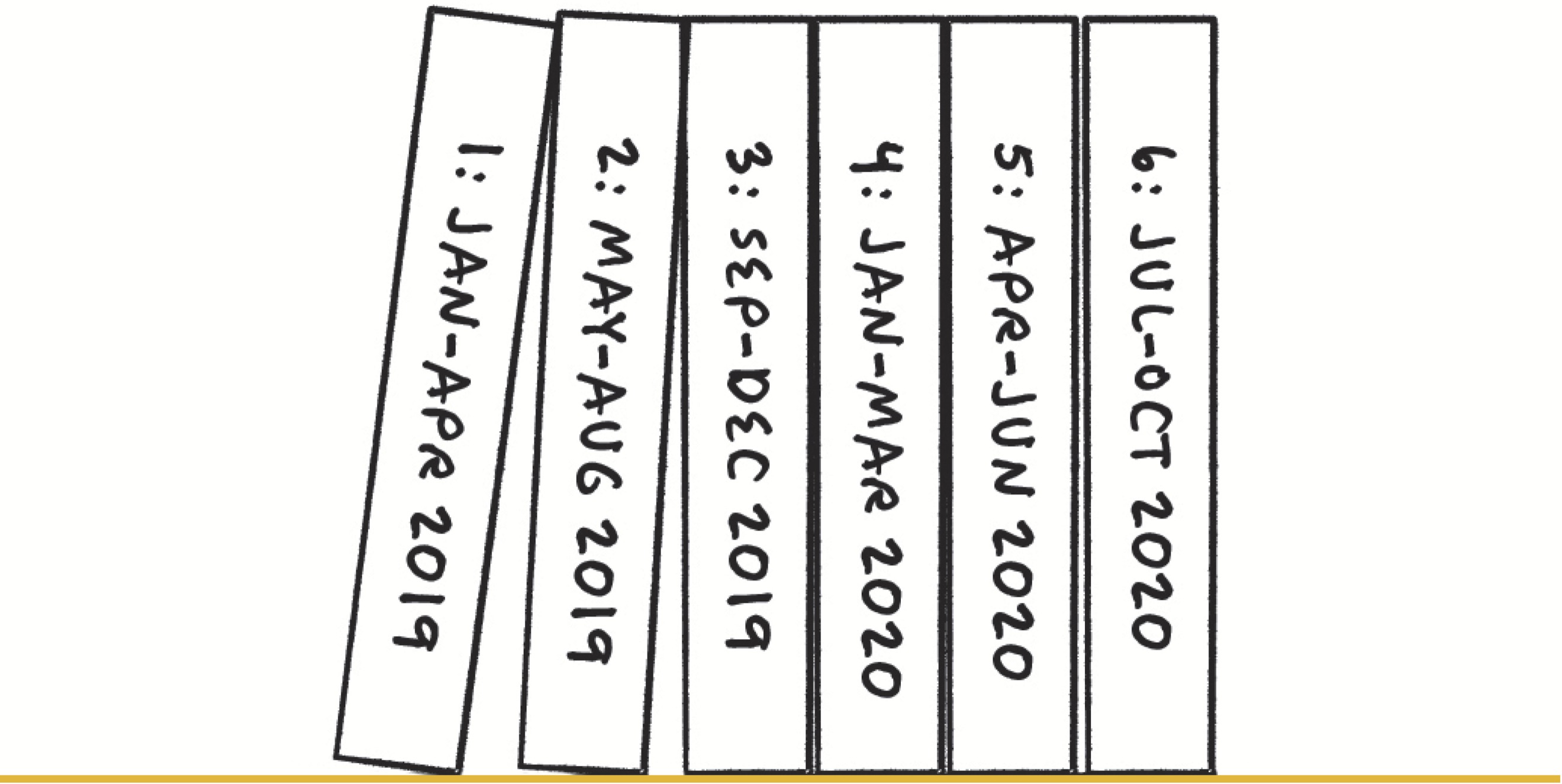
So are the Bullet Journal method and apps mutually exclusive? Of course not. There are many apps that make my life easier in ways that a notebook never could. All tools, whether digital or analog, are only as valuable as their ability to help you accomplish the task at hand. The goal of this book is to introduce you to a new tool kit for your workshop—one that has proven effective at helping countless others tackle the often ungainly project called life.
HANDWRITING
The palest ink is better than the best memory.
—CHINESE PROVERB
We breathe life into our thoughts by committing them to paper. Be they words, images, or notes, few tools facilitate the transition between the inner and outer worlds as seamlessly as the tip of a pen. In a world moving toward untextured interfaces, it may seem like an awkward step backward to implement a methodology that requires you to write things out the old-fashioned way. But a growing body of research points to the continued practicality of the handwritten word in our digital age.
A University of Washington study demonstrated that elementary school students who wrote essays by hand were far more likely to write in fully formed sentences and learn how to read faster. Much of this is due to how handwriting accelerates and deepens our ability to form—and therefore recognize—characters.17
The complex tactile movement of writing by hand stimulates our mind more effectively than typing. It activates multiple regions of the brain simultaneously, thereby imprinting what we learn on a deeper level. As a result, we retain information longer than we would by tapping it into an app.18 In one study, college students who were asked to take lecture notes by hand tested better on average than those who had typed out their notes. They were also able to better retain this information long after the exam.19
When we put pen to paper, we’re not just turning on the lights; we’re also turning up the heat. Writing by hand helps us think and feel simultaneously.
These studies and many like them indicate that the benefits of writing by hand stem from the very complaint consistently leveraged against it: inefficiency. That’s right: The fact that it takes longer to write things out by hand gives handwriting its cognitive edge.
It’s pretty much impossible to hand-transcribe lectures or meeting conversations verbatim. When we write by hand, we’re forced to be more economical and strategic with our use of language, crafting notes in our own words. To do that, we have to listen more closely, think about the information, and essentially distill others’ words and thoughts through our own neurological filtration system and onto the page. Typing notes, in contrast, can quickly become rote: a frictionless highway where information freely passes in one ear and right out the other.
Why is it so important to craft notes in your own words? The science suggests that writing by hand enhances the way we engage with information, strengthening our associative thinking. It allows us to form new connections that can yield unconventional solutions and insights. We’re simultaneously expanding our awareness and deepening our understanding.
How we synthesize our experiences shapes the way we perceive and interact with the world. This is why journaling has proven to be a powerful therapeutic tool in treating people who suffer from trauma or mental illness. Expressive writing, for example, helps us process painful experiences by externalizing them through long-form journaling. Cognitive behavioral therapy (CBT) uses scripts to treat people obsessing over intrusive thoughts. A distressing thought is detailed in a short paragraph. This script is then written over and over again until the thought begins to lose its death grip on the person’s mind, granting some much-needed perspective and distance—something we all struggle to find when dealing with challenging situations.
Toward our latter days, writing can help preserve our most cherished memories. Studies suggest that the act of writing keeps our minds sharper for longer. I’ve received many emails over the years praising Bullet Journal for helping those with poor memories stay organized, regardless of age. For instance, Bridget Bradley, a fifty-one-year-old Bullet Journalist, now remembers “what the weather was like three months ago, how many times I went to the gym last month, that I have made a reservation (by email) for that restaurant table, that I am going on holiday in July, and that I have already worked out what I need to take with me (six months in advance!) so that I have time to buy and prepare for it.” Similarly, I’ve heard from numerous people who found that Bullet Journaling helped their memory improve after being compromised by trauma or medical procedures.
A dear friend of mine once told me, “The long way is the short way.” In a cut-and-paste world that celebrates speed, we often mistake convenience for efficiency. When we take shortcuts, we forfeit opportunities to slow down and think. Writing by hand, as nostalgic and antiquated as it may seem, allows us to reclaim that opportunity. As we craft our letters, we automatically start filtering the signal from the noise. True efficiency is not about speed; it’s about spending more time with what truly matters. In the end, that’s what the Bullet Journal method is all about.
II
THE SYSTEM
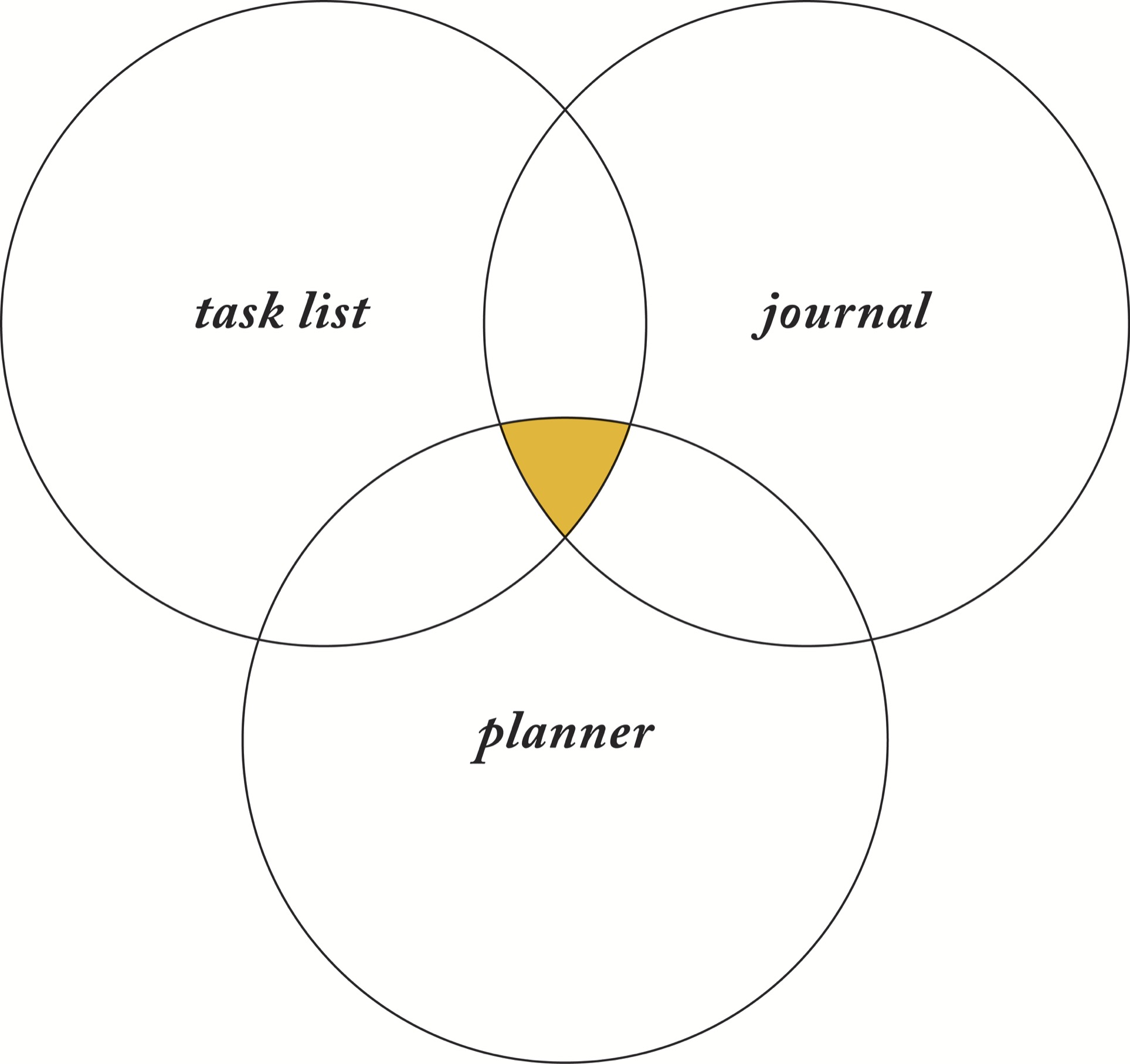
THE SYSTEM
Your Bullet Journal can be your to-do list, journal, planner, sketchbook, or all of the above, all in one place. This flexibility stems from its modular structure. An easy way to conceptualize the system is to imagine the pieces of a Lego set. Each piece of the Bullet Journal’s system serves a specific function, be it ordering your day, planning your month, or tackling a goal. You’re free to mix and match the pieces to customize the system to meet your needs. As those needs inevitably change over time, this flexibility allows the system to adapt and remain relevant through the different seasons of your life. As you evolve, so will the function and structure of your Bullet Journal.
In this part of the book, we’ll examine the core building blocks that lay the foundation of the system. You’ll learn how they work, why they work, and how they snap into the larger framework. If you’re following along in sequence, here’s where you’ll learn how to set up your own Bullet Journal and migrate the content from your Mental Inventory.
If you’re an old hand at this, Part II aims to take your BuJoJitsu to the next level. We’ll delve into the tools and techniques you’ve been using and explore the reasoning behind their design. This section functions both as a reference and a guide to help answer any questions that may have bubbled up during your time Bullet Journaling.
If you’re new to the Bullet Journal, I suggest reading through all the chapters in this part before setting pen to paper. Each method and technique is effective on its own, but the true power of the Bullet Journal is found in the sum of its parts. To get the most out of your BuJo experience, it’s important to understand how these parts interact and influence each other. This part will walk you through each step, how it works, and how to set up your own Bullet Journal step by step.
